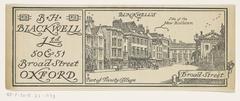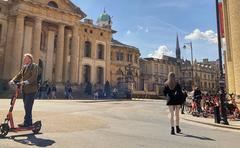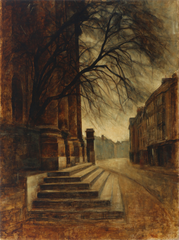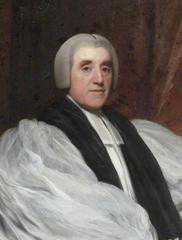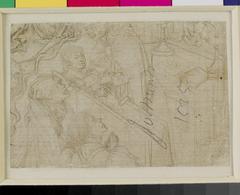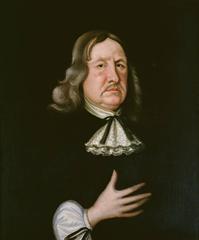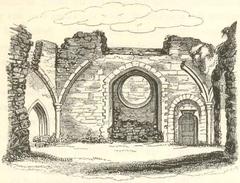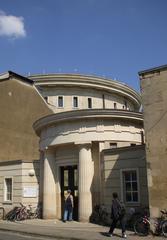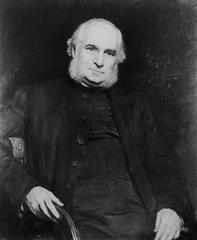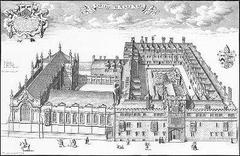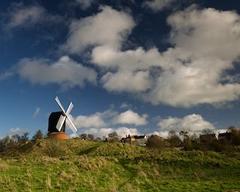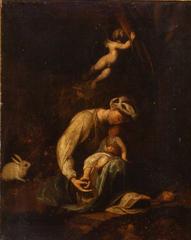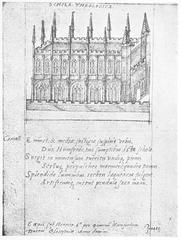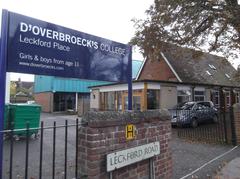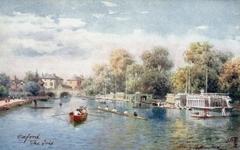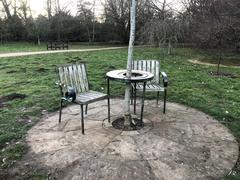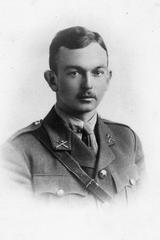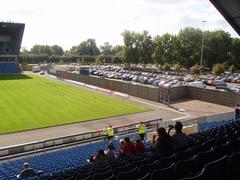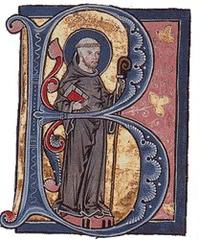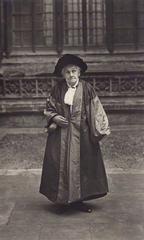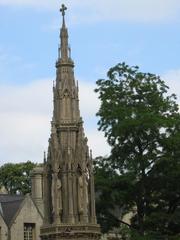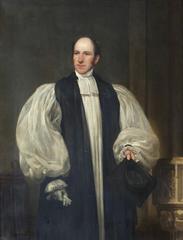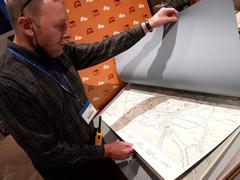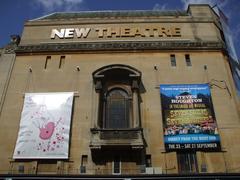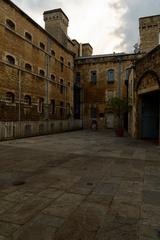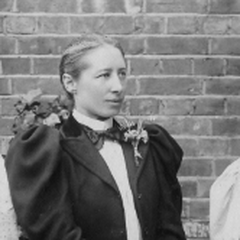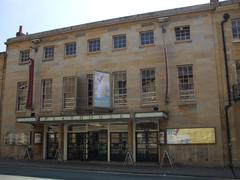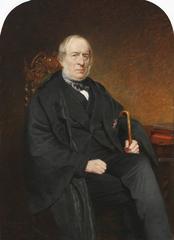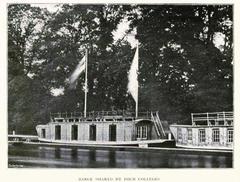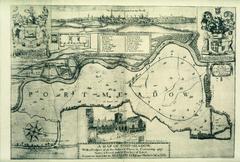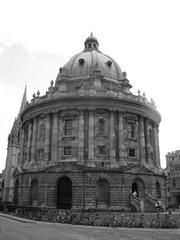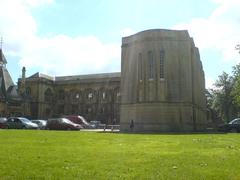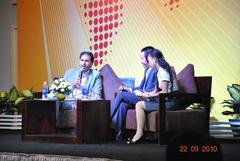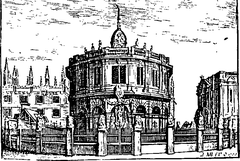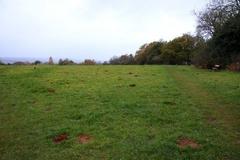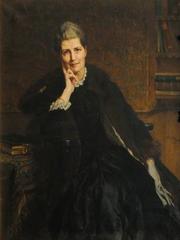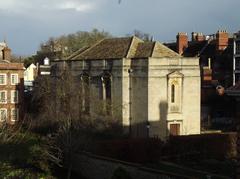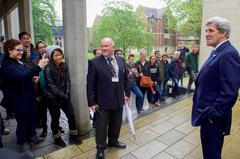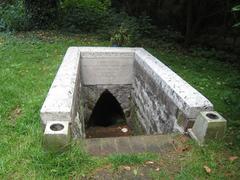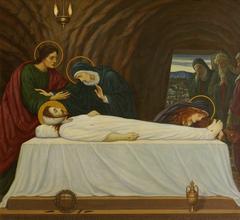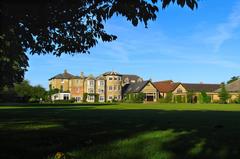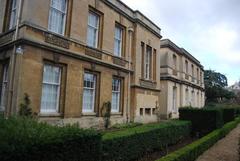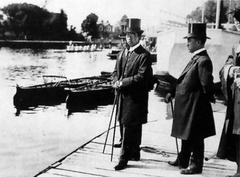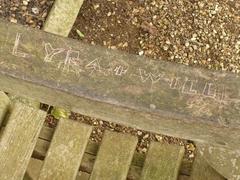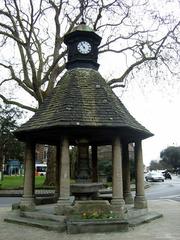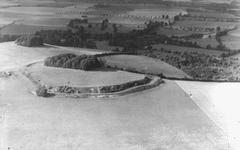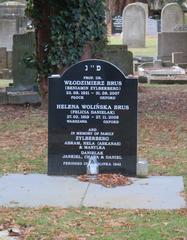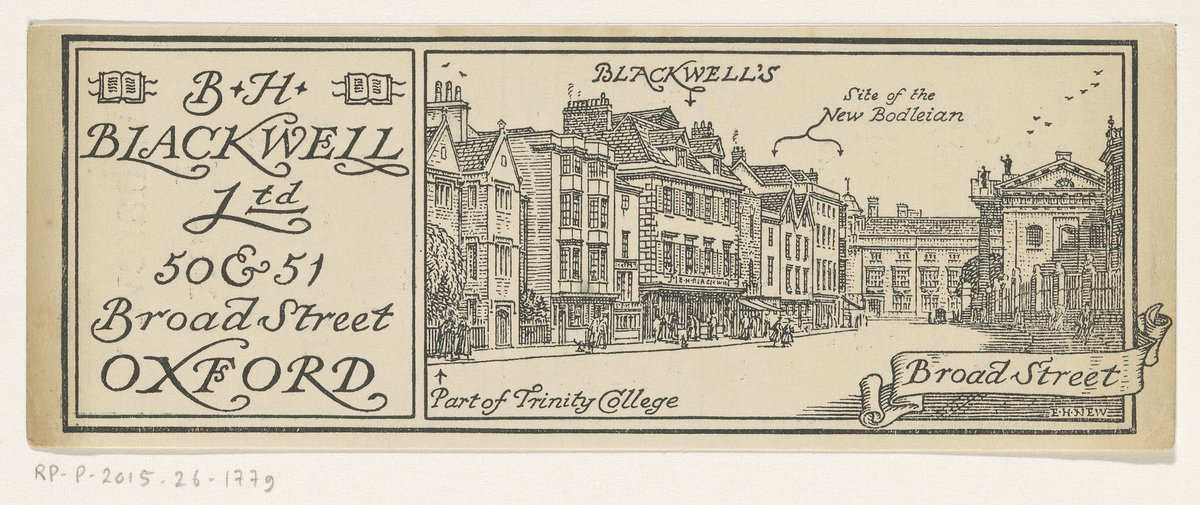
Clarendon Building Oxford: Visiting Hours, Tickets, and Historical Guide
Date: 14/06/2025
Introduction
The Clarendon Building is one of Oxford’s most iconic architectural achievements and a lasting symbol of the University’s academic tradition. Standing proudly on Broad Street, this early 18th-century English Baroque landmark was originally built to house the Oxford University Press. Today, although its interior is reserved for university administration, the building’s exterior remains a highlight for visitors seeking to explore Oxford’s rich heritage, classical architecture, and vibrant academic life. This guide provides detailed information on visiting hours, tickets, accessibility, historical context, and practical tips to help you make the most of your Oxford visit.
Table of Contents
- Overview and Historical Significance
- Quick Visitor Information
- Historical Background: Patronage and Construction
- Architectural Features and Style
- Planning Your Visit: Directions, Nearby Attractions, Tours
- Preservation and Restoration Efforts
- Accessibility Overview
- Travel Tips and Recommendations
- Visitor Flow and Surroundings
- Frequently Asked Questions (FAQ)
- Visuals and Interactive Elements
- Internal Links
- Conclusion and Visitor Summary
- References and Further Reading
Overview and Historical Significance
The Clarendon Building is a testament to the University of Oxford’s enduring commitment to scholarship and architectural excellence. Designed by Nicholas Hawksmoor, a protégé of Sir Christopher Wren, and completed between 1711 and 1715, the building was funded by profits from Edward Hyde, 1st Earl of Clarendon’s influential history of the English Civil War. Its classical symmetry, robust Portland stone façade, and statues of the nine Muses make it a masterpiece of English Baroque and a prominent figure in the city’s historic core (Oxford Preservation Trust; Britain Express).
Though primarily used for university administration today, the Clarendon Building forms a key part of guided walking tours and is surrounded by Oxford’s most celebrated landmarks, including the Bodleian Library, Sheldonian Theatre, and Radcliffe Camera (University of Oxford; Tours of Oxford).
Quick Visitor Information
- Visiting Hours: The Clarendon Building’s interior is not open to the public, except during occasional special events or guided tours. The exterior can be viewed at any time.
- Admission: No ticket is required to view the exterior. Guided tours that include the building may require advance booking and a fee.
- Accessibility: The building’s interior and entrances are not step-free. The exterior is accessible via Broad Street, but some pavements may be uneven.
- Location: At the corner of Broad Street and Catte Street, adjacent to major Oxford attractions.
Historical Background: Patronage and Construction
Built between 1711 and 1715, the Clarendon Building was funded through the proceeds of Hyde’s The History of the Rebellion, a work central to English political history. The University needed a dedicated home for its expanding Press, and Hawksmoor’s design reflected both the prestige and the scholarly mission of the institution.
Originally, the building housed the Oxford University Press until 1830. Later, it became the office space for senior university administrative functions, including the offices of the Vice-Chancellor and Bodleian Library staff (British History Online).
Architectural Features and Style
Baroque Influence and Classical Elements
Hawksmoor’s design showcases English Baroque restraint paired with Palladian symmetry and monumentality. The north façade features a grand portico supported by Doric columns and is crowned with statues of the nine Muses—iconic figures signifying the arts and sciences (Oxford Preservation Trust; Arts Festival Oxford). The Portland stone used throughout gives the structure both durability and visual brilliance.
The Nine Muses: History and Restoration
The lead statues atop the parapet, representing the nine Muses, have a storied past: initially refused by the University, they were installed after a two-year delay and have since been carefully restored and, in two cases, replaced with fiberglass replicas due to preservation challenges (Britain Express).
Planning Your Visit
Directions
- By Foot: Central city location, easily walkable from the train station and city center.
- By Bus: Major city bus routes stop close to Broad Street.
- By Car: Limited parking; Blue Badge bays are available on Keble Road (~200m away).
Nearby Attractions
- Bodleian Library: One of Europe’s oldest libraries, offering tours and exhibitions.
- Sheldonian Theatre: Historic venue for university ceremonies and concerts.
- Radcliffe Camera: Iconic circular library building nearby.
- Ashmolean Museum: World-class museum within walking distance.
Guided Tours and Events
The Clarendon Building is featured on many guided walking tours, which provide historical context and access to Oxford’s broader architectural legacy. Tours can be booked through local operators, the Oxford Visitor Centre, or providers like Footprints Tours and GPSmyCity.
Preservation and Restoration Efforts
Owing to its Grade I listed status, the Clarendon Building is subject to ongoing conservation efforts. Notably, the statues of the nine Muses have undergone several restorations, with recent projects focusing on preserving both the statuary and the stonework using historically compatible materials and expert conservation techniques (Arts Festival Oxford). Community engagement through public events and talks helps foster awareness and support for the building’s continued preservation (Oxford Preservation Trust).
Accessibility Overview
Physical Accessibility
- Entrances: All entrances have steps; there is no step-free access to the building interior (Oxford Access Guide).
- Lift: A small lift exists but is only accessible via stairs, so not suitable for wheelchair users.
- Toilets: An accessible toilet is located in the basement but only reachable by stairs.
- Surrounding Area: Pavements are generally wide but may have some uneven surfaces.
Visual and Sensory Accessibility
- No induction loops or tactile signage are available in the building.
- Visitors with hearing or visual impairments should plan accordingly.
Parking and Transport
- No on-site parking. Nearest Blue Badge bays are on Keble Road.
- Public Transport: Well-served by buses; taxis can drop off on Broad Street.
Accessible Nearby Facilities
- Weston Library Courtyard: Step-free access.
- Covered Market: Flat, accessible paths and restrooms.
- University Parks: Accessible entrances and restrooms.
- Clarendon Laboratory: Level access, lifts, and accessible toilets (Oxford Access Guide).
Travel Tips and Recommendations
- Best Time to Visit: Early mornings or late afternoons for fewer crowds and optimal lighting.
- Photography: The façade is best photographed from Broad Street; panoramic views available from the Sheldonian Theatre cupola.
- Booking Tours: Reserve guided tours in advance during peak tourist seasons.
- Accommodation: Options nearby include boutique hotels and larger establishments (Booking.com).
Visitor Flow and Surroundings
Broad Street is a lively pedestrian area, especially during term time. The central location makes it easy to include the Clarendon Building in a broader walking tour of Oxford’s main attractions. Shops, cafes, and other historic sites line the street, creating a vibrant atmosphere (Wanderlog).
Frequently Asked Questions (FAQ)
Q: Is the Clarendon Building open to the public?
A: The interior is not open to the public except during specific events or guided tours, but the exterior is always visible.
Q: Are tickets required?
A: No ticket is needed to view the exterior. Tours that include the Clarendon Building may require advance booking and a fee.
Q: Is the building wheelchair accessible?
A: There is no step-free access to the building’s interior. The surrounding area is generally accessible, but some pavements are uneven.
Q: How do I get there?
A: Located on Broad Street, easily reachable by foot, bus, or taxi. Blue Badge parking is available nearby.
Q: What are the best nearby attractions?
A: The Bodleian Library, Radcliffe Camera, Sheldonian Theatre, and Ashmolean Museum.
Visuals and Interactive Elements
- [Insert high-quality images of the Clarendon Building’s façade with alt text such as “Clarendon Building Oxford neoclassical façade”]
- [Embed map showing Clarendon Building’s location]
- [Include link to virtual tours of Oxford University Quarter if available]
Internal Links
Discover more about Oxford’s historical sites:
Conclusion and Visitor Summary
The Clarendon Building is a cornerstone of Oxford’s academic and architectural legacy. While its interior is not generally accessible, the building’s grand exterior, historical context, and integration with neighboring landmarks make it an essential stop for anyone exploring the city. Guided tours, nearby attractions, and central location enhance its appeal. For accessibility information, tour bookings, and the latest updates, consult official sources and download the Audiala app for curated experiences and audio guides.
Plan your visit today and immerse yourself in centuries of scholarship, artistry, and Oxford tradition!
References and Further Reading
- Oxford University Official Website
- Oxford Preservation Trust
- OxfordVisit.com
- Oxford Access Guide
- British History Online: Old Clarendon Building
- Arts Festival Oxford
- Tours of Oxford
- Footprints Tours: Clarendon Building
- GPSmyCity: Clarendon Building
- Britain Express: Clarendon Building Oxford
- Wanderlog: Most Historic Buildings and Sites in Oxford
- A Piece of Travel: Wheelchair Accessible Things to Do in Oxford
- Booking.com: Clarendon Building
